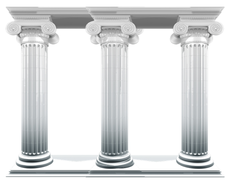
In my previous article, I detailed how to use the New Testament record of the life and ministry of Jesus to explain how he fulfilled Old Covenant messianic promises and prophecies. The New Testament colors in our picture of the Messiah, providing unexpected richness and clarity. The Gospel presents Jesus the Messiah King, who died for our sins and rose again in power, and who will return some day to judge the nations and rule over God’s kingdom forever. In this article, I will show how we can drive home this message to our hearers in a way that should provoke a response.
Once again, I am using Paul’s Gospel message that he delivered in Pisidian Antioch (Acts 13:14-41) for a model of how we can present it. I will also refer to Peter’s presentation on Pentecost (Acts 2:14-41) , another excellent example. As I mentioned before, there are a great variety of ways to share the Gospel, as can be seen when we examine the different times it was shared in the Book of Acts. Nevertheless, there is a basic pattern that should be followed, if we are going to present a complete gospel and not an inferior “Gospel Lite.” I admit that some situations do not provide the time to be thorough, but, when we do have the opportunity, we should take advantage of it.
We never want to give people an excuse to reject the Gospel because we presented it inadequately.
We must not inoculate people against the Gospel by giving them a small dose that enables the hearers to “wall off” future presentations, thinking that they have already heard it all. It took multiple chapters for each Gospel writer to present the story of Jesus. We cannot possibly do it in four easy steps. Jesus is much more than a bridge back to God. He is the reigning Lord of Lords.
The Gospel is a presentation of God’s Messiah King, not an abridged formula or plan that keeps us out of hell.
The Passion and Crucifixion
The heart of the Gospel is our Lord’s passion, crucifixion, resurrection, ascension, and the outpouring of the Holy Spirit baptism on Pentecost, which launched the church’s apostolic ministry. (Another important aspect of the Gospel is Christ’s Second Coming, which I will address in a future article.) Each Gospel writer gave us the most important details of this part of Jesus’ time on planet earth because in it we find the core of the Gospel message.
Just as a magnifying glass can focus sunlight into a single brilliant point that has the ability to ignite what it touches, the Gospel should bring its Old Covenant context and New Covenant explanation into a fiery focus at the crucifixion.
Jesus, the promised Messiah, was put to death unjustly in order to ransom us back to God!
"Brethren, sons of Abraham's family, and those among you who fear God, to us the message of this salvation has been sent. 27 "For those who live in Jerusalem, and their rulers, recognizing neither Him nor the utterances of the prophets which are read every Sabbath, fulfilled these by condemning Him. 28 "And though they found no ground for putting Him to death, they asked Pilate that He be executed. 29 "When they had carried out all that was written concerning Him, they took Him down from the cross and laid Him in a tomb. Acts 13:26-29 (NASB)
Jesus’ agony in the Garden of Gethsemane revealed that he laid down his life primarily to please his Father and secondarily for our sake; although, the two are inextricably linked. Jesus demonstrated his amazing love by voluntarily laying down his life for the church – for us. But more than that – if we really want to drive our message home as Paul did – we must emphasize that he not only died for us, but because of us. It was our sin and rebelliousness that he took upon himself so that we can share in his right relationship with God the Father.
Peter powerfully presented our guilt on that first New Covenant Pentecost.
"Men of Israel, listen to these words: Jesus the Nazarene, a man attested to you by God with miracles and wonders and signs which God performed through Him in your midst, just as you yourselves know— 23 this Man, delivered over by the predetermined plan and foreknowledge of God, you nailed to a cross by the hands of godless men and put Him to death. Acts 2:22-23 (NASB) It is vital that people understand the magnitude of the evil committed by those (us) who put God’s Son to death!
The Holy Spirit can and will take this important truth and use it to break our hearts and engender repentance. We should also explain that Christ’s sacrificial death is the sole reason for Father God’s offer of forgiveness and reconciliation, which Paul makes clear in the one of the passages quoted below.
This is the part of the Gospel that almost everyone presents, and it is vital, but it is not the end all. The Lamb of God ministry of Christ is a means to an end. Jesus died so that he might rise again in power and glory in order to enter into his Son of God / Son of Man Messianic King ministry. We should not curtail our Gospel presentation with the offer to receive forgiveness of sins. This trends toward being a consumerist Gospel that draws people to simply receive without any “strings attached.” It sounds wonderful, but it is not the full Gospel. Jesus did not die so that we can be forgiven and then do whatever we please. God’s purpose in saving us is to glorify himself by producing a multitude of sons (and daughters) who will reflect Christ’s character and ministry. Surrender to Christ’s Lordship is a very important “string” that we must trumpet thunderously, if we are doing to present to real Gospel.
Paul, a bond-servant of Christ Jesus, called as an apostle, set apart for the gospel of God, 2 which He promised beforehand through His prophets in the holy Scriptures, 3 concerning His Son, who was born of a descendant of David according to the flesh, 4 who was declared the Son of God with power by the resurrection from the dead, according to the Spirit of holiness, Jesus Christ our Lord, 5 through whom we have received grace and apostleship to bring about the obedience of faith among all the Gentiles for His name's sake, 6 among whom you also are the called of Jesus Christ; Romans 1:1-6 (NASB)
The Resurrection
If the Gospel were a musical symphony, the beginning would be a sonata-like lively presentation of the Old Covenant promises explained in the light of Christ’s birth and ministry, the focus of my first two articles in this series. The crucifixion would be a slow, somber adagio-like section, followed by a thunderous and lively allegro section that focuses on the resurrection. The finale would be a triumphant section that includes the giving of the Great Commission, the ascension, and the outpouring of the Spirit on Pentecost, with the promise of his coming back as judge of the living and the dead.
The resurrection turned what looked like a horribly disappointing and disillusioning tragedy into a rousing victory celebration beyond our wildest dreams. Let’s see how Paul and Peter constructed their resurrection portion of their message. First we have Paul at Pisidian Antioch.
"But God raised Him from the dead; 31 and for many days He appeared to those who came up with Him from Galilee to Jerusalem, the very ones who are now His witnesses to the people. 32 "And we preach to you the good news of the promise made to the fathers, 33 that God has fulfilled this promise to our children in that He raised up Jesus, as it is also written in the second Psalm, 'YOU ARE MY SON; TODAY I HAVE BEGOTTEN YOU.' 34 "As for the fact that He raised Him up from the dead, no longer to return to decay, He has spoken in this way: 'I WILL GIVE YOU THE HOLY and SURE blessings OF DAVID.' 35 "Therefore He also says in another Psalm, 'YOU WILL NOT ALLOW YOUR HOLY ONE TO UNDERGO DECAY.' 36 "For David, after he had served the purpose of God in his own generation, fell asleep, and was laid among his fathers and underwent decay; 37 but He whom God raised did not undergo decay. 38 "Therefore let it be known to you, brethren, that through Him forgiveness of sins is proclaimed to you, 39 and through Him everyone who believes is freed from all things, from which you could not be freed through the Law of Moses. Acts 13:30-39 (NASB)
Please take a few minutes to think deeply about these verses. Next let’s take a look at Peter’s presentation in Jerusalem on Pentecost.
"But God raised Him up again, putting an end to the agony of death, since it was impossible for Him to be held in its power. 25 "For David says of Him, 'I SAW THE LORD ALWAYS IN MY PRESENCE; FOR HE IS AT MY RIGHT HAND, SO THAT I WILL NOT BE SHAKEN. 26 'THEREFORE MY HEART WAS GLAD AND MY TONGUE EXULTED; MOREOVER MY FLESH ALSO WILL LIVE IN HOPE; 27 BECAUSE YOU WILL NOT ABANDON MY SOUL TO HADES, NOR ALLOW YOUR HOLY ONE TO UNDERGO DECAY. 28 'YOU HAVE MADE KNOWN TO ME THE WAYS OF LIFE; YOU WILL MAKE ME FULL OF GLADNESS WITH YOUR PRESENCE.' 29 "Brethren, I may confidently say to you regarding the patriarch David that he both died and was buried, and his tomb is with us to this day. 30 "And so, because he was a prophet and knew that GOD HAD SWORN TO HIM WITH AN OATH TO SEAT one OF HIS DESCENDANTS ON HIS THRONE, 31 he looked ahead and spoke of the resurrection of the Christ, that HE WAS NEITHER ABANDONED TO HADES, NOR DID His flesh SUFFER DECAY. 32 "This Jesus God raised up again, to which we are all witnesses. Acts 2:24-32 (NASB)
The resurrection affirms that our sins are forgiven because it proves that God the Father approved and received his sacrificial atonement for our sins. It also confirms that not only is Jesus God’s Lamb, he is God’s Messiah King, the Lord of lords, the glorious Son of Man prophesied by Daniel. Paul succinctly stated the import of the resurrection.
Therefore IT WAS ALSO CREDITED TO HIM AS RIGHTEOUSNESS. 23 Now not for his sake only was it written that it was credited to him, 24 but for our sake also, to whom it will be credited, as those who believe in Him who raised Jesus our Lord from the dead, 25 He who was delivered over because of our transgressions, and was raised because of our justification. Romans 4:22-25 (NASB) Paul, a bond-servant of Christ Jesus, called as an apostle, set apart for the gospel of God, 2 which He promised beforehand through His prophets in the holy Scriptures, 3 concerning His Son, who was born of a descendant of David according to the flesh, 4 who was declared the Son of God with power by the resurrection from the dead, according to the Spirit of holiness, Jesus Christ our Lord, Romans 1:1-4 (NASB)
The Ascension
Many Gospel presentations do not even include this section, which shows how far from God’s pattern we have strayed. The ascension of Christ further demonstrated that God the Father fully accepted the sacrificial death of his Son and installed him as the currently reigning and one-day coming again Lord and Judge of all the earth.
"Therefore having been exalted to the right hand of God, and having received from the Father the promise of the Holy Spirit, He has poured forth this which you both see and hear. 34 "For it was not David who ascended into heaven, but he himself says: 'THE LORD SAID TO MY LORD, "SIT AT MY RIGHT HAND, 35 UNTIL I MAKE YOUR ENEMIES A FOOTSTOOL FOR YOUR FEET."' 36 "Therefore let all the house of Israel know for certain that God has made Him both Lord and Christ—this Jesus whom you crucified." Acts 2:33-36 (NASB) The ascension marks Christ’s installment on the throne of heaven where he reigns until his enemies are finally defeated and he returns in glory to the earth he created and redeemed. It also marks the outpouring of the promised Holy Spirit, which fulfilled the last part of the ministry that John the Baptist prophesied – Baptizer in the Spirit. (You can read more about John the Baptist’s prophecies concerning Jesus by clicking here.) The giving of the Spirit provides believers with another benefit and requirement. The baptism in the Spirit equips and empowers us to obey Christ by being his witnesses in fulfillment of the Great Commission. (Acts 1:8)
Calling for a Proper Response
As any good salesman knows, closing is critical. A great presentation means nothing without a sale. We should never try to coerce or manipulate our hearers into a response, but we should give them a reason and opportunity to make one.
The proper reaction to the Gospel should be a sense of shock, sorrow, and amazement, coupled by a desire to get right with God. The proper response is a combination of repentance, faith, and surrender.
We err greatly If we fail to convey the magnitude of the sin of rejecting and crucifying God’s Son. We fail our hearers if we do not emphasize that surrender to Christ’s glorious lordship is central to the Gospel. If we omit the necessity of a life of obedience to this amazing Good Shepherd and Lord, we seriously damage a person’s chances to live in a way that brings the utmost glory to God.
Paul asked his hearers to “take heed” to his message, lest they be lumped among those whose hearts were hardened against God.
"Therefore take heed, so that the thing spoken of in the Prophets may not come upon you: 41 'BEHOLD, YOU SCOFFERS, AND MARVEL, AND PERISH; FOR I AM ACCOMPLISHING A WORK IN YOUR DAYS, A WORK WHICH YOU WILL NEVER BELIEVE, THOUGH SOMEONE SHOULD DESCRIBE IT TO YOU.'" Acts 13:40-41 (NASB)
Peter’s hearers on Pentecost were gripped by his Gospel presentation. When he announced that the one they crucified has been made the Lord of lords, they responded accordingly.
Now when they heard this, they were pierced to the heart, and said to Peter and the rest of the apostles, "Brethren, what shall we do?" Acts 2:37 (NASB)
Such a response is music in the preacher’s ears and glorifying to God. It is evidence of the activity of God’s Spirit following a convincing presentation of the Gospel. Those who heard Peter understood his message, their guilt, and the need to get right with God. Peter gave them a clear path to accomplish this.
Peter said to them, "Repent, and each of you be baptized in the name of Jesus Christ for the forgiveness of your sins; and you will receive the gift of the Holy Spirit. 39 "For the promise is for you and your children and for all who are far off, as many as the Lord our God will call to Himself." Acts 2:38-39 (NASB)
- Repent – The Spirit works in us to convict us of our root sin of trying to be the lord of our own lives. True repentance takes place when we acknowledge our sins, turn away from them, ask for and receive forgiveness, and surrender to Christ’s lordship. Faith is required for us to repent. We are not simply sorry for our sins. Rather we receive God’s amazing provision for us in Christ and commit to a lifetime of service to his Lordship.
- Be Water Baptized – Water baptism is a public demonstration of our repentance, faith, surrender to Christ, and our commitment to serve him for the rest of our lives.
- Receive the Baptism in the Holy Spirit – This equips Christ’s followers to fulfill the Great Commission. For more information on this, click here. We cannot adequately serve the Lord of the harvest without it.
Conclusion
My hope is that these three articles on the Anatomy of the Gospel have expanded and deepened your understanding of the Gospel and helped you see how important it is to share it thoroughly. According to Paul, the Gospel is the “power of God to salvation.” (Romans 1:16) Maybe the reason we do not see more power released to save people is because we are not properly presenting the Gospel. Let’s see what God will do when we better trumpet the most powerful message in the universe.


